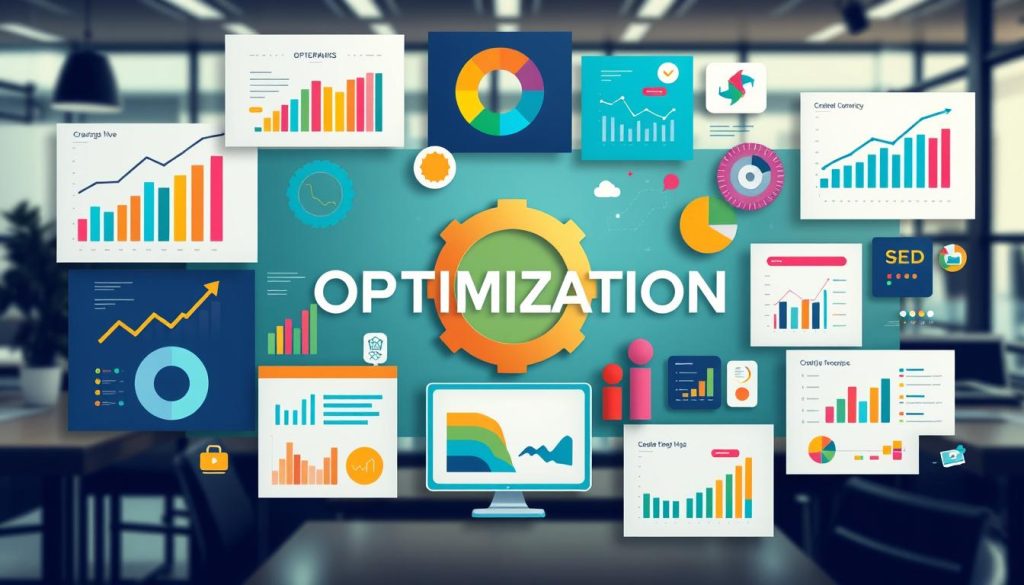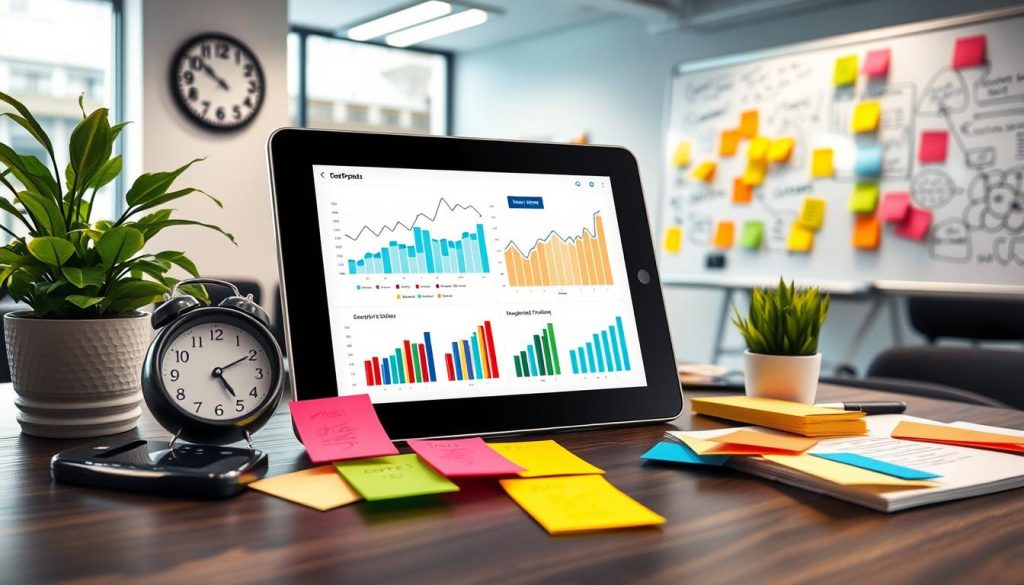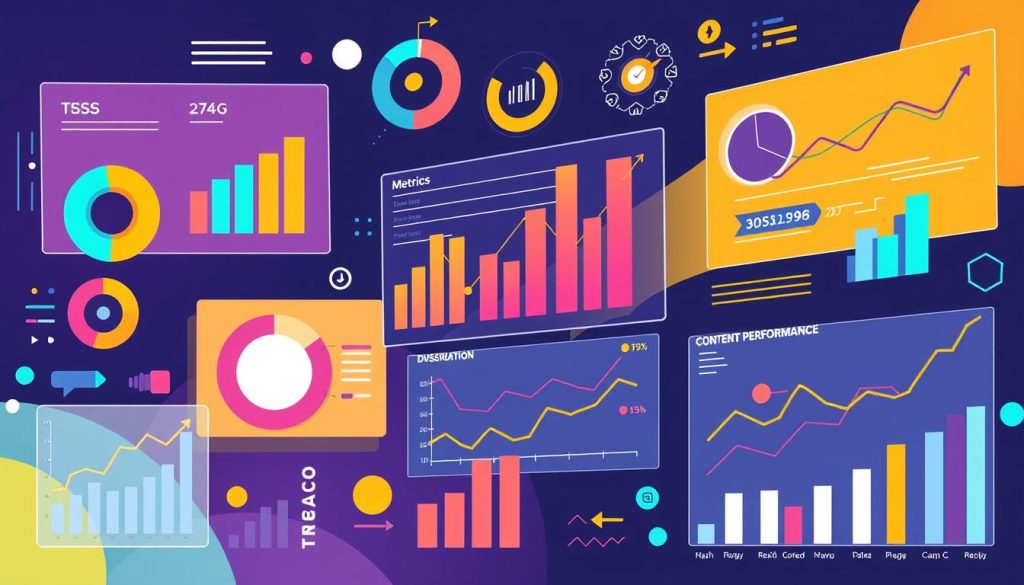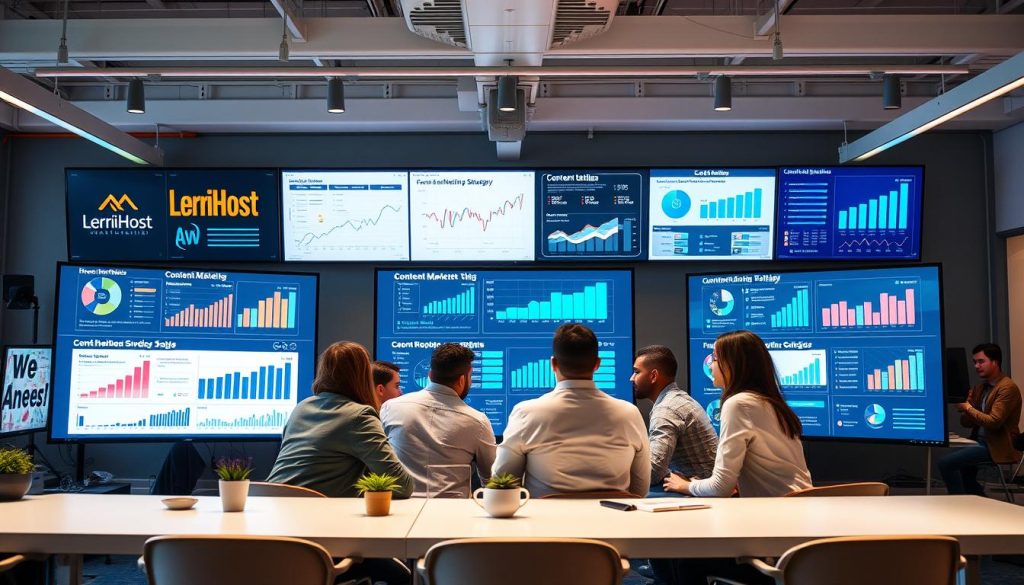In today’s digital landscape, the need to enhance content is more pressing than ever. At LerriHost, we grasp the significance of content impact in driving business expansion. We’ve gathered seven effective strategies to refine your content tactics and engage your audience.
These methods span from creating captivating headlines to refining visual aspects. They aim to boost your content’s effectiveness. Whether you’re an experienced marketer or new to the field, our guide will empower you to craft impactful content that resonates and yields results.
Are you ready to elevate your content? Explore these transformative tactics that will redefine your content creation approach and amplify your online footprint.
Key Takeaways
- Understand the fundamentals of content impact
- Learn to craft attention-grabbing headlines
- Optimise visual elements for maximum engagement
- Implement data-driven content strategies
- Enhance content distribution across platforms
- Leverage SEO best practices for improved visibility
- Create content that resonates with your target audience
Understanding the Fundamentals of Content Impact
In the digital marketing world, content impact is key to business success. We’ll look at the elements that shape content performance and its role in today’s digital scene.
Defining Content Impact in Today’s Digital Landscape
Content impact is about the measurable effects your digital content has on your audience and business goals. It includes engagement rates, conversion metrics, and brand awareness. In today’s digital world, content that connects with users can greatly enhance a company’s online presence and profits.

Why Content Performance Matters for Business Growth
Tracking content performance is vital for business growth. It helps companies:
- Identify top-performing content types
- Understand what their audience likes
- Use resources wisely
- Boost ROI on marketing
By examining these aspects, businesses can tweak their strategies and see better outcomes in their digital marketing efforts.
The Role of Content Quality in Digital Marketing
High-quality content is the foundation of successful digital marketing. It fosters trust, establishes authority, and boosts engagement. Quality content:
- Draws in and keeps visitors
- Boosts search engine rankings
- Generates leads and conversions
- Strengthens brand reputation
Investing in content quality is essential for lasting success in the competitive digital world.
| Content Quality Factor | Impact on Digital Marketing |
|---|---|
| Relevance | Increases user engagement and time on site |
| Accuracy | Builds trust and credibility |
| Originality | Improves SEO rankings and share-ability |
| Readability | Enhances user experience and comprehension |
Making Content Better Through Strategic Planning
Strategic planning is the cornerstone of effective content creation. A well-thought-out content strategy ensures your efforts meet business objectives and connect with your audience. By focusing on content planning, you can streamline your workflow and produce more impactful material.

To enhance your content, begin by setting clear objectives. What do you aim to achieve? Whether it’s boosting brand awareness, generating leads, or increasing sales, your goals should steer your content creation.
Next, conduct in-depth audience research. Knowing your readers’ needs, preferences, and challenges will enable you to craft content that resonates with them. This targeted approach can significantly boost engagement and conversion rates.
“Content improvement begins with knowing your audience inside out.”
Creating a content calendar is vital for consistent output. It aids in planning topics, allocating resources, and maintaining a steady publishing schedule. Below is a sample content calendar structure:
| Week | Topic | Format | Target Audience | Distribution Channels |
|---|---|---|---|---|
| Week 1 | SEO Best Practices | Blog Post | Small Business Owners | Website, LinkedIn, Email |
| Week 2 | Social Media Tips | Infographic | Marketing Managers | Instagram, Twitter, Pinterest |
| Week 3 | Email Marketing Guide | Whitepaper | E-commerce Businesses | Website, Email, LinkedIn |
By adopting these content planning strategies, you’ll be on the path to creating more effective and engaging content. This content will drive results for your business.
Crafting Compelling Headlines and Introductions
The art of crafting headlines and introductions is vital for grabbing reader attention. A well-crafted headline can be the difference between a click and a scroll-by. An engaging introduction keeps readers hooked on your content.
Psychology Behind Effective Headlines
Effective headlines tap into human psychology. They spark curiosity, promise value, or create urgency. For instance, headlines with numbers or questions often perform well. They set clear expectations or pique interest.

Structure of Attention-Grabbing Introductions
Content introductions must hook readers immediately. Start with a surprising fact, a relatable anecdote, or a thought-provoking question. Then, outline what readers can expect from the rest of the content. This gives them a reason to keep reading.
Tools for Testing Headline Performance
Headline testing is key for optimising content impact. Several tools can help measure and improve headline performance:
| Tool | Features | Best For |
|---|---|---|
| CoSchedule Headline Analyzer | Scores headlines based on word balance, length, and sentiment | Blog posts and articles |
| Optimizely | A/B testing for headlines and introductions | Websites and landing pages |
| BuzzSumo | Analyses top-performing headlines in your industry | Content marketers and publishers |
By focusing on headline writing, perfecting introductions, and using testing tools, you can greatly enhance your content’s initial impact and overall performance.
Optimising Visual Elements for Maximum Engagement
Visual content is key to boosting engagement. Incorporating eye-catching images, infographics, and videos can greatly enhance your content’s appeal. Let’s dive into strategies for optimising visuals to captivate your audience.

Choosing the right visuals is critical. Opt for images that complement your text and reinforce your message. High-quality, relevant visuals can make text-heavy content more accessible. Remember, visuals should enhance, not overshadow, your core message.
Optimising images is vital for both user experience and SEO. Compress images to ensure fast loading without losing quality. Use descriptive file names and alt text to boost accessibility and search engine visibility.
“A picture is worth a thousand words, but only if it’s the right picture.”
Creating custom infographics can present complex data simply. Infographics are highly shareable, boosting engagement on social media.
Video content is becoming more popular, increasing time on your page. Use short, engaging videos to explain concepts, demonstrate products, or share testimonials.
- Use consistent branding across all visual elements
- Experiment with different types of visuals to see what resonates with your audience
- Regularly update your visual content to keep it fresh and relevant
By prioritising visual content optimisation, you can create a more engaging and memorable experience. This will drive better results for your content marketing efforts.
Implementing Data-Driven Content Strategies
Data-driven content strategies are vital for increasing your content’s impact. By using content analytics and metrics, you can make informed decisions. This is about how you create and distribute your content.
Key Metrics for Content Performance
Understanding key performance indicators is essential for measuring content success. Some vital content metrics include:
- Page views and unique visitors
- Time on page
- Bounce rate
- Social shares
- Conversion rates
Using Analytics to Guide Content Decisions
Content analytics offer valuable insights into audience behaviour and preferences. By analysing these data points, you can refine your content strategy. This leads to more engaging material.
For instance, if you notice high bounce rates on certain pages, it might indicate a need for more captivating introductions. Or better-targeted content.

Tools and Platforms for Content Analysis
Several tools can help you implement data-driven content strategies:
| Tool | Primary Function | Key Feature |
|---|---|---|
| Google Analytics | Website traffic analysis | Comprehensive audience insights |
| SEMrush | SEO and content marketing | Keyword research and tracking |
| BuzzSumo | Content performance tracking | Social media engagement analysis |
By utilising these tools and focusing on content metrics, you can create a robust, data-driven content strategy. This strategy will resonate with your audience and drive business growth.
Enhancing Content Distribution Channels
Effective content distribution is key to maximising your marketing impact. By using various channels, you can engage a broader audience. Let’s look at some strategies to boost your content’s reach.
Social Media Distribution Strategies
Social media marketing is essential for content distribution. Each platform needs a unique approach to connect with its audience. For example, Instagram is great for visual content, while LinkedIn is better for professional insights.

Email Marketing Integration
Email marketing is a powerful tool for content distribution. Create engaging newsletters that highlight your latest content. Segment your email list to send personalised content that matches each group’s interests.
Cross-Platform Content Syndication
Expand your reach by syndicating content across platforms. Repurpose your content into different formats, like turning blog posts into infographics or podcasts. This strategy caters to diverse audience preferences and extends your content’s lifespan.
| Distribution Channel | Best Content Types | Frequency |
|---|---|---|
| Social Media | Short-form, visual | Daily |
| Long-form, curated | Weekly | |
| Content Syndication | Repurposed, varied | Monthly |
By adopting these content distribution strategies, you can greatly increase your reach and engagement. Always review your results and tweak your strategy based on performance. This will help continually enhance your content’s impact.
Leveraging SEO Best Practices for Content Visibility
Boosting your SEO content is essential for better visibility in search results. By applying key search engine optimisation techniques, you can boost your online presence. This attracts more organic traffic to your site.

Begin with thorough keyword research to find terms your target audience uses. Use these keywords naturally in your content, including headers, meta descriptions, and body text. Quality is more important than quantity when using keywords.
Write compelling meta descriptions that summarise your content well and encourage clicks. These snippets are key to increasing click-through rates from search engine results pages.
- Optimise header tags (H1, H2, H3) to structure your content logically
- Create detailed, authoritative content that meets user needs
- Use internal linking to guide visitors and distribute page authority
- Ensure your website is mobile-friendly and loads quickly
By following these SEO best practices, you’ll enhance your content’s visibility. This will attract more qualified traffic to your site. Remember, successful SEO is a continuous effort. It requires consistent work and adapting to changing search engine algorithms.
“Great SEO work only gets better over time. It’s only search engine tricks that need to keep changing when the algorithms change.” – Jill Whalen
Creating Content That Resonates with Your Target Audience
Creating content that truly connects with your audience is essential for successful marketing. Understanding your target demographic and tailoring your message is key. This approach enables you to craft impactful content that boosts engagement and drives conversions.
Understanding Audience Demographics
Knowing your audience is vital for effective audience targeting. Utilise tools like Google Analytics to gather data on age, location, and interests. Create detailed buyer personas to represent your ideal customers. Include their goals, challenges, and preferences in these personas.

Mapping Content to Customer Journey
Align your content with different stages of the customer journey to provide value at every touchpoint. Consider these stages:
- Awareness: Educational blog posts and infographics
- Consideration: Case studies and product comparisons
- Decision: Customer testimonials and free trials
- Retention: How-to guides and exclusive content
Personalisation Techniques
Content personalisation enhances user experience and boosts engagement. Implement these strategies:
| Technique | Description | Example |
|---|---|---|
| Dynamic Content | Adjust content based on user data | Personalised product recommendations |
| Segmentation | Group users by shared characteristics | Industry-specific email campaigns |
| Behavioural Triggers | Respond to user actions | Abandoned cart reminders |
By focusing on audience targeting, mapping content to the customer journey, and using personalisation techniques, you can create content that truly resonates with your audience. This approach drives results.
Building Content Authority Through Expert Insights
Establishing content authority is vital for brands looking to make a mark online. By tapping into expert insights, companies can craft thought leadership content that connects with their audience. This solidifies their status as industry leaders.

Collaborating with industry experts is a key strategy for building content authority. This method boosts your content’s credibility and offers valuable insights to your audience. Think about conducting interviews with thought leaders or hosting guest posts from respected professionals in your field.
Original research is another potent tool for establishing content authority. By conducting surveys, analysing data, or performing case studies, you can produce unique, data-driven content. This content sets you apart from competitors, showing your dedication to innovation and knowledge-sharing.
“Content authority is not just about what you know, but how you share that knowledge with your audience.”
To effectively showcase your expertise, consider creating a content series that tackles common industry challenges or explores new trends. This approach allows you to dive deep into complex topics. You provide your audience with valuable, in-depth insights.
| Content Type | Benefits | Examples |
|---|---|---|
| Expert Interviews | Diverse perspectives, increased credibility | Q&A sessions, podcast episodes |
| Original Research | Unique insights, data-driven authority | Industry reports, trend analyses |
| Case Studies | Real-world applications, problem-solving expertise | Client success stories, project breakdowns |
Remember, building content authority is a continuous effort. Consistently producing high-quality, expert content will establish your brand as a trusted source in your industry. This drives engagement and builds long-term audience loyalty.
Maximising Content Longevity and Sustainability
Creating content that endures is key to digital marketing success. This section delves into methods to extend your content’s lifespan. It also explores how to keep it relevant in a rapidly evolving online world.
Content Update Strategies
Ensuring your content remains fresh and current is vital. Regular updates are necessary to maintain SEO rankings and provide accurate information to your audience. Here are some strategies to consider:
- Review and update statistics and data annually
- Add new insights or industry developments
- Refresh examples to reflect current trends
- Update internal and external links

Repurposing Content Effectively
Repurposing content is a great way to give old materials a new lease on life. By converting your content into various formats, you can engage new audiences and reinforce your message. Here are some repurposing techniques to try:
- Turn blog posts into infographics or videos
- Create podcast episodes from popular articles
- Compile related blog posts into an ebook
- Extract key points for social media posts
By prioritising evergreen content and using effective update and repurposing strategies, you can maximise your content’s longevity and impact. This approach not only saves time and resources but also builds a strong content library. It continues to offer value over time.
Measuring and Scaling Content Success
Measuring content success is vital for businesses looking to enhance their content ROI. By monitoring key performance indicators, you can assess your content strategy’s effectiveness. This allows for informed decisions on future campaigns.

Scaling content becomes straightforward with a clear understanding of what succeeds. Utilise performance measurement tools to pinpoint your most effective content. Analyse why it connects with your audience. This knowledge enables you to replicate success across various content types and channels.
To calculate content ROI, consider these factors:
- Content creation costs
- Distribution expenses
- Revenue generated
- Lead quality and quantity
- Engagement metrics
After identifying successful content, focus on scaling your efforts. Streamline production by creating templates, planning a content calendar, and using automation tools. This method ensures quality while boosting output.
“The key to successful content scaling is finding the right balance between quantity and quality. Always prioritise value for your audience.”
Scaling content isn’t solely about increasing production; it’s about amplifying your best pieces. Consider repurposing top content into different formats or updating evergreen articles. By combining effective performance measurement with strategic scaling, you’ll maximise your content’s impact. This drives long-term business growth.
How LerriHost Implements These Tactics
LerriHost excels in the digital world by leveraging content marketing strategies. Their methods offer valuable lessons for businesses aiming to boost their online footprint.
Real-World Case Studies
LerriHost’s content marketing case studies highlight significant achievements. A small e-commerce business witnessed a 150% surge in organic traffic following LerriHost’s content strategy. Another example shows a 75% increase in lead generation for a B2B software company.

Implementation Strategies
LerriHost’s strategies centre on bespoke content creation. They begin with thorough audience research, then craft compelling, SEO-optimised content. Their methodology includes:
- Creating buyer personas
- Developing content calendars
- Utilising data-driven keyword research
- Implementing regular content audits
Results and Outcomes
The outcomes of LerriHost’s content marketing efforts are impressive. Clients generally see:
| Metric | Average Improvement |
|---|---|
| Organic Traffic | 85% increase |
| Conversion Rates | 35% boost |
| Brand Awareness | 60% growth |
These outcomes underscore the success of LerriHost’s content marketing strategies. They offer a roadmap for businesses looking to enhance their digital presence.
Conclusion
In today’s digital landscape, boosting your content’s impact is essential. We’ve delved into seven effective tactics to enhance your content strategy. These include crafting compelling headlines and optimising visuals, all aimed at improving your content’s performance.
Understanding your audience is fundamental. Use data to create content that truly connects with your readers. Implement SEO best practices and expand your distribution channels to boost visibility. Regularly update and repurpose your content to keep it fresh and relevant.
By adopting these proven strategies, you can significantly enhance your content’s impact and engagement rates. Begin implementing these tactics today and witness your content’s success. Have you employed any of these methods? We’re eager to hear about your experiences in elevating your content’s effectiveness!
